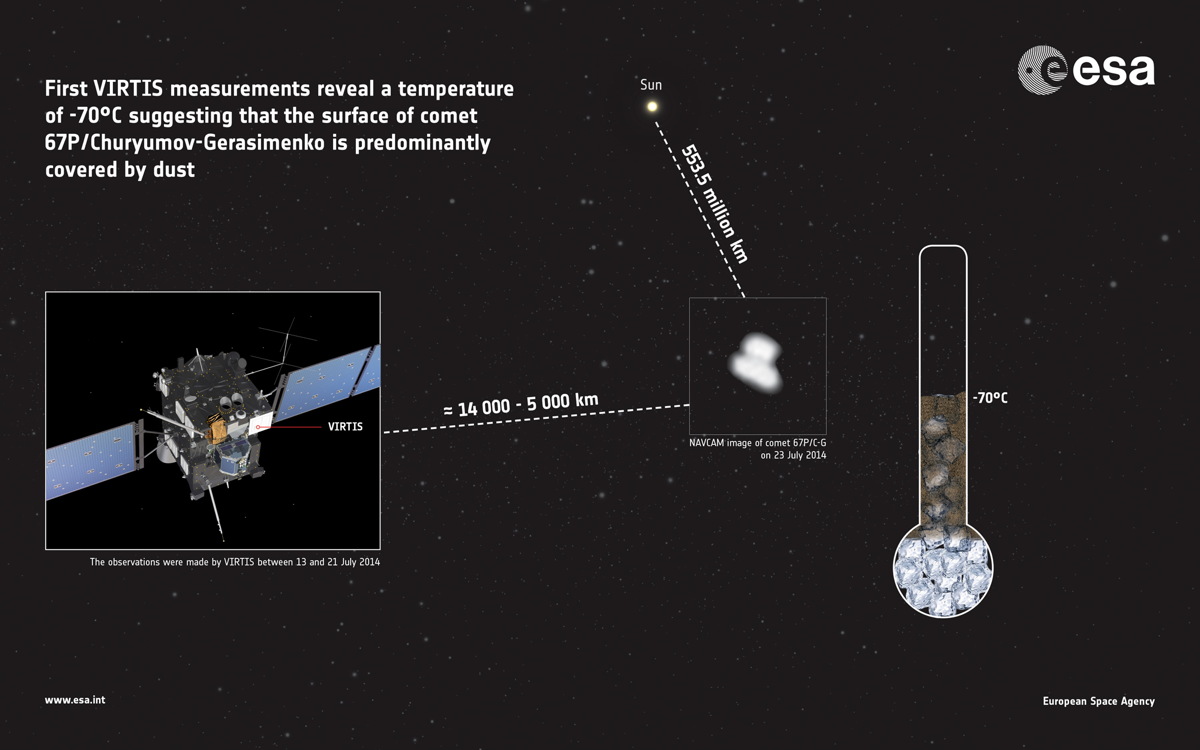Rosetta Spacecraft Takes Temperature of Comet 67P

As the European-built Rosetta spacecraft neared its close encounter with a comet last week, it turned up a cosmic surprise: the comet is warmer than scientists were expecting.
The Rosetta probe took the temperature of Comet 67P/Churyumov-Gerasimenko as well as high-resolution photos of the comet ahead of its Aug. 6 arrival at the icy celestial wanderer. From a distance of 145 miles (234 kilometers) away — less than the distance between New York City and Baltimore — Rosetta revealed a pockmarked nucleus that appears to have some higher sections than others. The comet itself has been compared to a rubber ducky due to its shape.
Temperatures of the comet taken in mid-July by the Rosetta's visible, infrared and thermal imaging spectrometer — nicknamed VIRTIS for short — show that the average surface temperature is minus 94 degrees Fahrenheit (minus 70 degrees Celsius). [Photos: Europe's Rosetta Comet Mission in Pictures]
This is much warmer than would be expected of a comet that is covered in ice, so researchers suspect it is evidence that the comet has a somewhat dusty surface, possibly with ice patches. European Space Agency officials noted that other comets have had similar types of surfaces, such as 1P/Halley.
The temperatures were taken while the probe was between 3,106 miles and 8,699 miles away (5,000-14,000 kilometers). The observations are consistent with ground-based looks at the comet, which revealed that it had a low reflectivity.
The Rosetta spacecraft will remain with Comet 67P/Churyumov-Gerasimenko as the icy object makes its closest approach to the sun, between the orbits of Earth and Mars. Controllers also plan to deploy a lander called Philae in November.
VIRTIS' role will be to look at how the surface temperature changes in different areas of the comet, to better understand how these objects change as they get closer to the sun.
Breaking space news, the latest updates on rocket launches, skywatching events and more!
This will also make it easier to select a landing site for Rosetta's lander Philae (which will land in November) because controllers will get a sense as to the thermal conductivity, density and porosity of the surface's top few inches, the European Space Agency stated.
Follow Elizabeth Howell @howellspace, or Space.com @Spacedotcom. We're also on Facebook and Google+. Original article on Space.com.

Elizabeth Howell (she/her), Ph.D., was a staff writer in the spaceflight channel between 2022 and 2024 specializing in Canadian space news. She was contributing writer for Space.com for 10 years from 2012 to 2024. Elizabeth's reporting includes multiple exclusives with the White House, leading world coverage about a lost-and-found space tomato on the International Space Station, witnessing five human spaceflight launches on two continents, flying parabolic, working inside a spacesuit, and participating in a simulated Mars mission. Her latest book, "Why Am I Taller?" (ECW Press, 2022) is co-written with astronaut Dave Williams.
